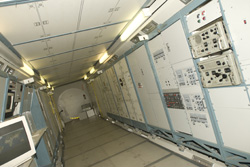How microbes spread inside spacecraft
People spend more than 90 % of their time indoors or in vehicles, therefore it's not surprising that biocontamination in enclosed areas is an important health issue. This is particularly true on manned space flights where biocontamination can present a risk to both the crew and onboard equipment. The 'Biocontamination specific modeling in habitats related to space' (BIOSMHARS)(opens in new window) project developed and tested a mathematical model for predicting the transportation of bioaerosols in a closed environment and the spread of biocontamination. The initiative's aim was to create a tool for predicting the dispersal of the airborne microbial contamination. Researchers predicted airflow and temperature distribution and also took into consideration different types of human bioaerosol emissions. A 3D computational fluid dynamics (CFD) model was also developed to reflect normal gravity, which will be improved to reflect microgravity conditions. Project partners conducted a review of current procedures related to biocontamination in spacecraft and discovered that there was a need for further improvements in engineering systems. A reliable model for predicting bioaerial distribution in closed habitats was used to test habitat design and to develop adequate monitoring and prevention procedures for airborne microbial contamination. Strains of microorganisms isolated from samples retrieved from the International Space Station (ISS) were used in studies and included the fungus Penicillium expansum and two bacteria, Staphylococcus epidermidis and Bacillus subtilis. The purity of the generated bioaerosols was examined together with their stability, source strength and size distributions. A model was established that showed airflow in a confined space, the generation and dispersion of microbial contaminant, and its deposition on surfaces. Calibration of the model was carried out at the BIOS-3 closed ecosystem facility in Krasnoyarsk, Russia as an analogue to the ISS to enable it to be adapted to a real spacecraft. The study of the complex phenomena of microbial dispersion through air and deposition onto surfaces in a confined environment will also be of value in hospitals, aircraft, and the pharmaceutical and food industries. The project therefore provided valuable information for reducing the bio burden and contributed to clean room design and quality control, including pharmaceutical plants.







